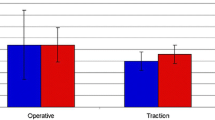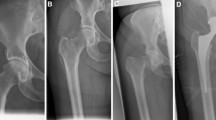Abstract
Introduction
The application of traction in hip arthroscopy is associated with peri-operative complications. Within a therapeutic case series, patient-related factors correlating with high-traction forces during hip arthroscopy and occurring complications should be identified.
Materials and methods
In 30 male and 38 female patients (mean age: 44.5 years), intra-operative traction forces were monitored continuously using a specialised measurement device. A multivariate analysis was employed to identify patient-related factors influencing the traction force. Peri-operative complications (follow-up: 12 weeks) were evaluated by performing a single-case analysis.
Results
The mean initial force prior to penetration of the capsule (“initial force”) was 477 N (men: 517 N; women: 444 N), decreasing after capsulotomy by an average of 17 %. The male gender (p < 0.001), Kellgren and Lawrence radiographic stage (p = 0.037), low minimum joint-space width (p = 0.029) and high body height/weight (p = 0.003/0.037) correlated significantly with higher distraction forces. The patient age and type of anaesthesia (general versus spinal) were not relevant. Complications were observed in ten patients on the first post-operative day. In two of these patients a partial sensory deficit of the lateral cutaneous femoral nerve persisted after 12 weeks. All patients with complications required initial traction forces of >400 N.
Conclusions
The study revealed several patient-specific risk factors correlating with high-traction forces during hip arthroscopy. With view to potential complications, these patient groups require special attention during surgical treatment as well as in future studies.


Similar content being viewed by others
References
Glick JM, Valone F 3rd, Safran MR (2009) Hip arthroscopy: from the beginning to the future—an innovator’s perspective. Knee Surg Sports Traumatol Arthrosc 22:714–721
Lynch TS, Terry MA, Bedi A et al (2013) Hip arthroscopic surgery: patient evaluation, current indications, and outcomes. Am J Sports Med 41:1174–1189
Jayakumar P, Ramachandran M, Youm T et al (2012) Arthroscopy of the hip for paediatric and adolescent disorders: current concepts. J Bone Joint Surg Br 94(3):290–296
Villar RN (1994) Arthroscopy. BMJ 308:51–53
Griffin DR, Villar RN (1999) Complications of arthroscopy of the hip. J Bone Joint Surg Br 81:604–606
Pailhé R, Chiron P, Reina N et al (2013) Pudendal nerve neuralgia after hip arthroscopy: retrospective study and literature review. Orthop Traumatol Surg Res 99:785–790
Glick JM (2001) Hip arthroscopy. The lateral approach. Clin Sports Med 20:733–747
Telleria JJ, Safran MR, Harris AH et al (2012) Risk of sciatic nerve traction injury during hip arthroscopy—is it the amount or duration? An intra-operative nerve monitoring study. J Bone Joint Surg Am 94:2025–2032
Möckel G, Labs K (2014) Complications in hip arthroscopy and follow-up therapy. Analysis over a 5-year time period with a total of 13,000 cases. Orthopade 43:6–15 (German)
Dippmann C, Thorborg K, Kraemer O et al (2014) Symptoms of nerve dysfunction after hip arthroscopy: an under-reported complication? Arthroscopy 30:202–207
Sampson TG (2001) Complications of hip arthroscopy. Clin Sports Med 20:831–835
Papavasiliou AV, Bardakos NV (2012) Complications of arthroscopic surgery of the hip. Bone Joint Res 1(7):131–144
Dietrich F, Ries C, Eiermann C et al (2014) Complications in hip arthroscopy: necessity of supervision during the learning curve. Knee Surg Sports Traumatol Arthrosc 22:953–958
Dienst M, Grün U (2008) Complications of hip arthroscopies. Orthopade 37:1108–1109, 1111–1115 (German)
Kocaoğlu H, Başarır K, Akmeşe R et al (2015) The effect of traction force and hip abduction angle on pudendal nerve compression in hip arthroscopy: a cadaveric model. Arthroscopy 31:1974–1980
Dienst M (2006) Hip arthroscopy. Technique for positioning and distraction. Orthopade 35:33–40 (German)
Dienst M, Seil R, Gödde S et al (2002) Effects of traction, distension, and joint position on distraction of the hip joint: an experimental study in cadavers. Arthroscopy 18:865–871
Ochs BC, Herzka A, Yaylali I (2012) Intra-operative neurophysiological monitoring of somatosensory evoked potentials during hip arthroscopy surgery. Neurodiagn J 52:312–319
Kellgren JH, Lawrence JS (1957) Radiological assessment of osteo-arthrosis. Ann Rheum Dis 16(4):494–502
Byrd JW, Pappas JN, Pedley MJ (1995) Hip arthroscopy: an anatomic study of portal placement and relationship to the extra-articular structures. Arthroscopy 11:418–423
Mason JB, McCarthy JC, O’Donnell J et al (2003) Hip arthroscopy: surgical approach, positioning, and distraction. Clin Orthop Relat Res 406:29–37
Ellenrieder M, Tischer T, Kreuz PC et al (2013) Arthroscopically assisted therapy of avascular necrosis of the femoral head. Oper Orthop Traumatol 25:85–94 (German)
ME-Meßsysteme GmbH, Hennigsdorf, Germany. Data sheet KD191.2014. http://www.me-systeme.de/de/datasheets/kd191.pdf. Accessed 13 Jan 2015
Eriksson E, Arvidsson I, Arvidsson H (1986) Diagnostic and operative arthroscopy of the hip. Orthopedics 9:169–176
Grøntvedt T, Engebretsen L (1995) Arthroscopy of the hip. Scand J Med Sci Sports 5:7–9
Arvidsson I (1990) The hip joint: forces needed for distraction and appearance of the vacuum phenomenon. Scand J Rehabil Med 22:157–161
Elsaidi GA, Ruch DS, Schaefer WD et al (2004) Complications associated with traction on the hip during arthroscopy. J Bone Joint Surg Br 86:793–796
Harris JD, McCormick FM, Abrams GD et al (2013) Complications and reoperations during and after hip arthroscopy: a systematic review of 92 studies and more than 6,000 patients. Arthroscopy 29:589–595
Kendall FP, Kendall McCreary E et al (1993) Muscles—testing and function, 4th edn. Lippincott Williams and Wilkins, Baltimore
Fukushima K, Takahira N, Uchiyama K et al (2016) The incidence of deep vein thrombosis (DVT) during hip arthroscopic surgery. Arch Orthop Trauma Surg 136(10):1431–1435. doi:10.1007/s00402-016-2508-7
Acknowledgments
The authors wish to thank Antje Rybandt for her assistance in statistical analysis.
Author information
Authors and Affiliations
Corresponding author
Ethics declarations
Conflict of interest
No conflict of interest declared.
Rights and permissions
About this article
Cite this article
Ellenrieder, M., Tischer, T., Bader, R. et al. Patient-specific factors influencing the traction forces in hip arthroscopy. Arch Orthop Trauma Surg 137, 81–87 (2017). https://doi.org/10.1007/s00402-016-2572-z
Received:
Published:
Issue Date:
DOI: https://doi.org/10.1007/s00402-016-2572-z




